________________
refuted a syllogism made by Dharmottara, as well as the Vaiknyikas such as Vyomabiva severely censured each Buddhist syllogism. They said that if it is not a prasanga - but rather #vatantronūdhona, it commits the fallacy of non-establishment of the locus. An Inr nr we con now survey the extant texts, Sankarasvimin, who is mentioned in the TSP, seems to be the earliest Naiyyika commentator who criticized Buddhist syllogisma, dividing them into prasn'ga- and Avatantrosidhanas. As referred to above, this problem of abrayis idella arose at different stage in the discussion, i.e. in the trentment of the vyatircka in the demonstration of momentariness. As I discussed in a previous paper,' ) we can safely say that the asrayāsiddha was variously and repeatedly discussed in the contexts of refuting unreal objects and establishing momentariness of phenomena in the last half of the 9th century (i.e. by Bhāsarva jña) and the 10th century (i.e. by Vyomobiva and Vācaspati).
Asoka. Asoka in his Avayavinirākarapa introduces the refutation of a whole with a syllogism in the form of vytipokaviruddhopalnbdhi: "What in wrongly connected with contradictory propertion, is not a unity, as for example a jor. A gross and 2.8. blue object is wrongly connected with contradictory properties." In this connection, he clearly says that the locus of this syllogism is not the whole, but a gross blue object which
is grasped through direct perception (pratyakşa), 80 that the syllogism
does not commit the fallocy of non-establishment of the locus.5) in
that case, however, another question ariser: Does not the locus in
question have anything to do with the whole? Thin question is answered
through the following statement :
(Opponent:) "In that case (viz., if the locus is not the whole but the gross blue object,] the oneness of the whole would not be denied through (the reason) 'false connection with contradictory properties.'" (Author:) If you say so, then what do you mean by "the whole"? (Opponent:) "It is the object which is one and inherent in many parts." (Author:) 1s it different from the manifesting gross and e.g. blue object, or not? Firstly, it cannot be different, because you admit (its perceptibility, and nothing manifests as different
--5




